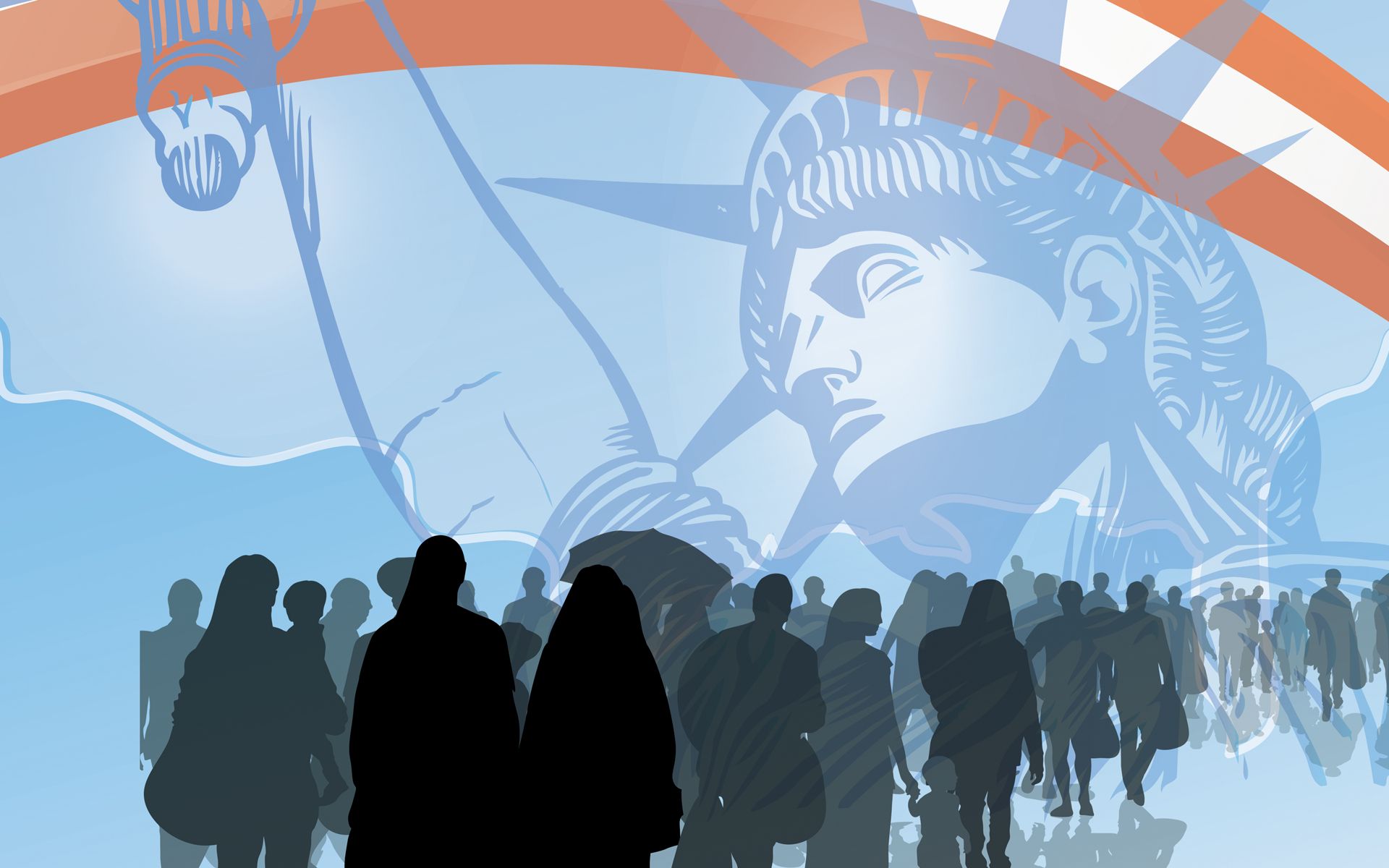Immigration and the Effect of Integration in Societies

In This Article
-
How do immigrant communities preserve their identity through shared experiences of language, religion, politics, all while their identity is constantly being revised?
-
The belief that the growing number of immigrants threatens traditional American customs and values is less prevalent (averaging about 43 percent) than the belief that migrants strengthen American society (52 percent).
-
For many immigrants, religious institutions are the most welcoming venue by which to get involved in society.
In the United States, immigrants often face a crisis of identity that is familiar to many who live abroad. This crisis can be thought of as a struggle between the desire for cultural integration and the fear of cultural assimilation. On the one hand, immigrants usually come to a new country because they want to participate in its culture and economy and, at some level, reap the economic, cultural, or political benefits of this participation. On the other hand, such participation can lead to anxiety if it causes the immigrant to feel alienated from the traditions of his or her home country. In this article, we will look at how immigrant communities navigate this dilemma and how they seek to preserve their identity through shared experiences of language, religion, politics, and the consumption of media, all the while their identity is constantly being revised and altered by their encounters with mainstream American culture.
The three main groups entering the US in recent decades are Latin Americans, Asians, and, in significantly smaller numbers, immigrants or refugees from Muslim countries. These immigrants come to the United States for a variety of reasons, but most come seeking a better life than the one available to them in their home country. And for asylum seekers, life in their home country may not be an option anymore, due to political persecution, violence, or other reasons. They come to find peace and solace as well as opportunities to achieve self-realization. Statistically, immigrants believe in the American Dream more than Americans do. According to the General Social Survey conducted by NORC, almost 70 percent of immigrant parents say their children will prosper relative to themselves, compared with only 50 percent of native-born parents [1]. Clearly such newcomers desire some degree of cultural integration, and in their optimism regarding the possibilities of American life, they could even be considered “more American” than the native-born population.
Whereas immigrants come to the US with great expectations, attitudes toward immigrants vary. The belief that the growing number of immigrants threatens traditional American customs and values is less prevalent (averaging about 43 percent) than the belief that migrants strengthen American society (52 percent) [2]. Another common finding is that Americans clearly want immigrants to be integrated with US society. One indicator of this can be traced in a recent survey in which 76% of Americans said that they support the requirement of English proficiency for legal citizenship (Pew Research Center, 2013) [3]. Since bilingualism is one of the most visible manifestations of cultural difference, this group of Americans sees it as a threat to American culture and native-born leadership. However, some Americans believe that multilingualism among immigrant communities benefits American creativity and dynamism (Huntington, 2004; Alba, 2005). In the professional world, bilingualism is often highly rewarded, so immigrants who are able to maintain fluency in their native language while also gaining proficiency in English may find themselves more qualified for employment than if they had “lost” their first language. This is one example of the possible benefits of cultural integration as opposed to full assimilation into monolingual American culture. According to research, bilingualism has also been linked to other positive cognitive outcomes, including increased attention control, working memory, metalinguistic awareness, and abstract and symbolic representation skills (Adesope et al., 2010). Hence, for immigrants, it is important not to succumb to the pressure to assimilate to monolingual English-speaking culture, as there are many benefits to a more bilingual integration. In light of all of this, the best possible deal would be to retain one’s native language while also becoming proficient in English.
Such an approach would also resolve a major concern of first-generation immigrants: linguistic isolation. There is a strong correlation between the English proficiency level of a first- or second-generation immigrant and his or her level of cultural integration. Many studies show that English proficiency changes marriage patterns and increases a person’s ability to engage in native civic organizations and political discourse, which are very important factors in integration. In 2013, 22 percent of children living in immigrant families lived in linguistically isolated households. These children were observed to struggle in education due to their parents’ difficulty communicating with school staff and monitoring their children’s progress (Batalova and Fix, 2010; Fix and Capps, 2005; Gifford and Valdes, 2006). Data shows that these linguistically isolated kids have higher anxiety.
It’s observed that after the third generation, an immigrant family usually loses their native language to English.
Is there a middle way between cultural integration and isolation? There are some patterns that might prove beneficial to immigrants and families navigating this difficulty. For instance, in the Latino community, families maintain Spanish proficiency for up to five generations on average. While one major reason for this linguistic continuity is the frequent replenishment of the Spanish-speaking population in the United States, the prevalence of and access to Spanish-language media in the United States plays another important role. Immigrants from Latin America reported that they typically watch Spanish TV, unlike other groups who watch primarily English channels. Access to native language TV and a sizable (enough) community of native language speakers can effectively preserve language habits in immigrants, which can allow them to integrate bilingually.
Religion is another important aspect of culture that can face dramatic changes in the process of cultural integration. Even though it is difficult to measure religiosity—we can’t easily determine the strength of people’s beliefs—one reliable indicator could be religious service attendance. According to the data, roughly a quarter (27%) of all Christian immigrants in the survey attended religious service once or twice a month. By comparison, about six in ten (62%) of all Christians in the United States say they attend religious services at least once or twice a month (Pew Research Center, 2013). Muslims also saw a drop in religious attendance after immigration, with only 32% of immigrants attending regular services. According to Massey and Higgings (2001), one reason for the decline could be that some immigrants do not intend to stay permanently, so they may be less motivated to get involved in religious groups. The only exception to this trend is Jewish immigrant communities, where attendance remains essentially unchanged; every other major religious group observed a drop in weekly attendance of services.
Even though evaluating religiosity depending on religious service attendance is plausible, for Muslim communities this might not be a reliable indicator. Since Islam does not strictly require attendance to mosque for women, the data only represents male religiosity. One interesting finding that supports this fact is reflected in a study in which Muslim immigrants are found to be more religious than other major immigrant groups. According to the study, 65% of first generation and 60% of second-generation immigrants perform salah, the daily ritual prayer, every day. Additionally, 30% of Muslim women in immigrant communities wear headcovers when they are in public.
Yet, regardless of what the data on religiosity says, one significant factor to having thriving religious communities is the presence of welcoming religious institutions that offer community outreach and engagement opportunities. For those immigrants who do continue to attend regular religious services, religious institutions play a major role in integration. Membership in religious groups provides an alternative source of respectability for those who feel denied social recognition in the United States. Also, religious communities provide an array of resources for immigrants such as information about jobs, housing, and classes in English. Temples, mosques, synagogues, and churches can help immigrants gain upward social mobility by providing classes like English and SAT preparation. Also, involvement in religious institutions prevents youth from using drugs or joining gangs. For many immigrants, religious institutions are the most welcoming venue by which to get involved in society. It is even noted that some Latin American immigrants left Catholicism for smaller Evangelical churches because these churches provided more opportunity to culturally integrate through personal and supportive relationships.
The question for immigrants is how to maintain their cultural traditions while still integrating into a new social landscape. In addition to changes in linguistic and religious practices, immigrants also face adjustments to their culture and/or lifestyle. These also include changes in their mindset and their political views and attitudes. As immigrants spend time in the US for longer periods, we see that they tend to change their views on various political issues. One interesting finding is their view on the role of federal government [4]. On average, one-third of native-born people think that “the government in Washington is trying to do too many things that should be left to individuals and private businesses,” while a quarter disagree and believe the government should do more to solve the country's issues. Immigrants differ from native-born citizens on this topic, as they are considerably more likely to feel that the government should do more (36%) rather than believing that it does too much (15%), which is a near reverse of native-born citizens' views. However, it is observed that immigrant views ideas converge with native-born as they spend more time in America.
Furthermore, immigrants’ cultural integration may also affect their health. According to research, foreign-born immigrants live, on average, 3.4 years longer than the native-born population. The main reason is thought to be their change in eating habits. Immigrants consume less processed food than the native-born population, which lowers their rates of cardiovascular disease, obesity, and cancer.
Another dramatic change and a clear mark of cultural integration is intermarriage, which is becoming more and more common in America. Between 2008 and 2012, more than half of marriages involving immigrants had one native-born partner (Lichter et al., 2015a). In 2010, about one of every seven marriages were found to be interracial or interethnic, which is more than twice the rate in 1980 (Wang, 2012; Frey, 2014). Intermarriage has led a dramatic increase in the mixed-race population. In the United States, the percentage of multiracial babies increased from 1% in 1970 to 10% in 2013.
To turn our attention to American society, there is a group of native-born Americans who oppose immigration of any kind, regardless of how it might benefit society. One reason given for this opposition is the belief that immigrants commit more crimes. However, the data shows that foreign-born males are jailed at one-fourth the rate of native-born men in the 18-39 age group. There is no evidence that immigrants are more dangerous or criminal than native-born Americans. On the other hand, crime rates in the second and third generations of immigrants tend to be similar to those in the native-born population, a finding which some researchers interpret as a negative consequence of integration. Yet, healthy integration is something to aspire to, given its benefits both for immigrants and natives.
Whether one desires it or not, immigrants in America face dramatic changes in their culture, especially after the second generation, which is usually the generation that shows the last remnants of their grandparents’ culture. Indeed, after the second generation, immigrant culture becomes almost identical with American culture. But whether or not these changes result in integration or a more total assimilation has much to do with the support of religious institutions, immigrant support groups, and access to native-language media and communities.
Notes
- Data from NORC’s General Social Survey (GSS) at http://www3.norc.org/Gss+website/ [September 2015].
- See http://www.people-press.org/files/legacy-pdf/3-28-13%20Immigration%20Release.pdf [November 2015].
- See http://www.people-press.org/files/legacy-pdf/6-23-13%20Immigration%20Release%20 Final.pdf November 2015]
- See NORC’s General Social Survey website for variables and wording of questions at http:// www3.norc.org/GSS+Website/Browse+GSS+Variables/Subject+Index/ [November 2015].
References
- Fry, R., and Lopez, M.H. (2012). IV. College graduation and Hispanics. Pew Research Center Hispanic Trends. Available: http://www.pewhispanic.org/2012/08/20/iv-collegegraduation-and-hispanics/ [July 2015].
- Burt, L., and Batalova, J. (2014). Refugees and Asylees in the United States. Washington, DC: Migration Information Source. Available: http://www.migrationpolicy.org/article/ refugees-and-asylees-united-states [March 2015].
- Huntington, S.P. (2004). The Hispanic challenge. Foreign Policy, 141(2), 30-45. Iceland, J., and Scopilliti, M. (2008). Immigrant residential segregation in U.S. metropolitan areas, 1990-2000. Demography, 45(1), 79-94.
- Adesope, O.O., Lavin, T., Thompson, T., and Ungerleider, C. (2010). A systematic review and meta-analysis of the cognitive correlates of bilingualism. Review of Educational Research, 80(2), 207-245.
- Massey, D., and Higgins, M.E. (2011). The effect of immigration on religious beliefs and practice: A theologizing or alienating experience? Social Science Research, 40(5), 1371-1389.
- Wang, W. (2012). The Rise of Intermarriage. Washington, DC: Pew Research Center.









